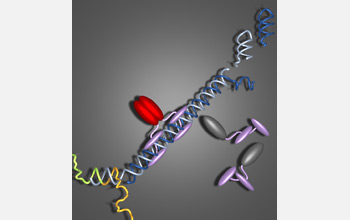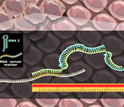News Release 10-160
These Cells Will Self-Destruct in Five ... Four ...
New treatment activates death program in cancer cells

Small conditional RNAs (light and dark blue) selectively kill cancer cells.
September 6, 2010
Watch a video illustrating how small conditional RNAs can target and kill individual cancer cells.
This material is available primarily for archival purposes. Telephone numbers or other contact information may be out of date; please see current contact information at media contacts.
Cancer is a difficult disease to treat because it's a personal disease. Each case is unique and based on a combination of environmental and genetic factors. Conventional chemotherapy employs treatment with one or more drugs, assuming that these medicines are able to both "diagnose" and "treat" the affected cells. Many of the side effects experienced by chemotherapy patients are due to the fact that the drugs they are taking aren't selective enough. For instance, taking a drug that targets fast-growing tumor cells frequently results in hair loss, because cells in the hair follicle are among some of the fastest growing in the body. When it comes down to it, these drugs get the diagnosis wrong.
But what if we had cancer treatments that worked more like a computer program, which can perform actions based on conditional statements? Then, a treatment would kill a cell if--and only if--the cell had been diagnosed with a mutation. Only the defective cells would be destroyed, virtually eliminating unwanted side effects.
With support from the National Science Foundation (NSF), researchers at the California Institute of Technology have created conditional small RNA molecules to perform this task. Their strategy uses characteristics that are built into our DNA and RNA to separate the diagnosis and treatment steps.
"The molecules are able to detect a mutation within a cancer cell, and then change conformation to activate a therapeutic response in the cancer cell, while remaining inactive in cells that lack the cancer mutation," claims Niles Pierce, co-author of a recent study which appears in the September 6 issue of Proceedings of the National Academy of Sciences (PNAS).
This work is part of the Molecular Programming Project, funded by NSF's Directorate for Computer & Information Science & Engineering. One of the goals of the project is to increase understanding of how information can be stored and processed by molecules, and how we might create practical applications that utilize that information.
At the heart of this approach is ribonucleic acid or RNA, and all of the normal tasks it performs each and every day to keep our cells alive and healthy. RNA is the relatively short-lived counterpart of DNA, the coding system that stores full copies of our entire genome within almost every cell of our body. If we think of DNA as information stored on the hard drive of a computer, then RNA is like information stored on a more volatile kind of memory like RAM--which is erased when you switch off your computer.
RNAs perform all kinds of functions in a cell, acting as messengers and switches to communicate and monitor which genes are expressed in a cell at any given time. A particular class of RNAs, called small RNAs, is less than 30 base pairs in length (an average gene is thousands of base pairs long). These small bits of RNA are involved in many of the processes that maintain life. The treatment developed by Pierce and his colleagues relies on two separate small RNAs that structurally mimic those that occur naturally within our own cells. Because these molecules resemble small RNAs that are normally present, the researchers hope there will be few, if any side effects.
"By de-coupling diagnosis and treatment, we can create molecules that are both highly selective and highly effective in killing cancer cells," said Pierce. "Conceptually, small conditional RNAs have the potential to transform cancer treatment because they change what we can expect from a molecule. Many years of work remain to establish whether this conceptual promise can be realized in human patients."
Here's how it works: Treatment involves two different small RNAS. The first small RNA will open up if--and only if--it finds the cancer mutation. A positive "diagnosis" exposes a signal that was previously hidden within the small RNA. Once this small RNA is open, a second small RNA binds to it, setting off a chain reaction in which these RNA molecules continue to combine to form a longer chain. The length of the chain is an important part of the "treatment." Longer chains trick the cell into thinking it has been invaded by a virus, tripping a self-destruct response.
In the PNAS study, researchers demonstrated that this approach effectively eliminates lab-grown human brain, prostate and bone cancer cells in a mutation-specific manner. Future experiments will determine whether the treatment is effective on a larger scale.
-NSF-
-
View Video
This video illustrates how small conditional RNAs can target and kill individual cancer cells.
Credit and Larger Version
Media Contacts
Lisa Van Pay, NSF, (703) 292-8796, email: lvanpay@nsf.gov
Kathy Svitil, California Institute of Technology, (626) 395-8022, email: ksvitil@caltech.edu
Program Contacts
Mitra Basu, NSF, (703) 292-8946, email: mbasu@nsf.gov
Principal Investigators
Niles Pierce, California Institute of Technology, (626) 395-8086, email: niles@caltech.edu
The U.S. National Science Foundation propels the nation forward by advancing fundamental research in all fields of science and engineering. NSF supports research and people by providing facilities, instruments and funding to support their ingenuity and sustain the U.S. as a global leader in research and innovation. With a fiscal year 2023 budget of $9.5 billion, NSF funds reach all 50 states through grants to nearly 2,000 colleges, universities and institutions. Each year, NSF receives more than 40,000 competitive proposals and makes about 11,000 new awards. Those awards include support for cooperative research with industry, Arctic and Antarctic research and operations, and U.S. participation in international scientific efforts.
Connect with us online
NSF website: nsf.gov
NSF News: nsf.gov/news
For News Media: nsf.gov/news/newsroom
Statistics: nsf.gov/statistics/
Awards database: nsf.gov/awardsearch/
Follow us on social
Twitter: twitter.com/NSF
Facebook: facebook.com/US.NSF
Instagram: instagram.com/nsfgov

